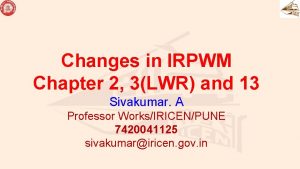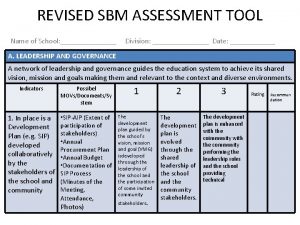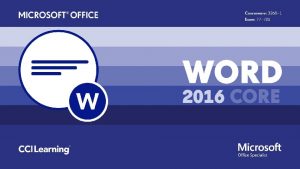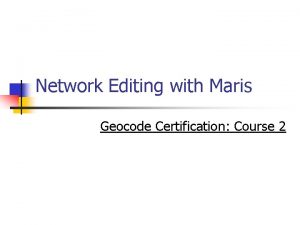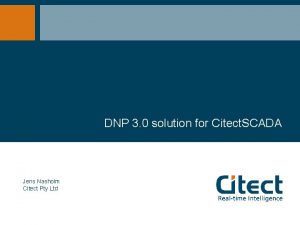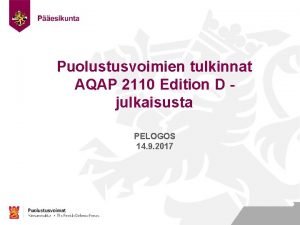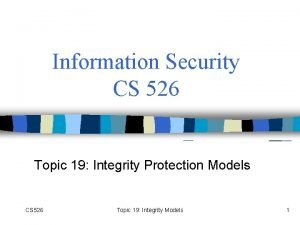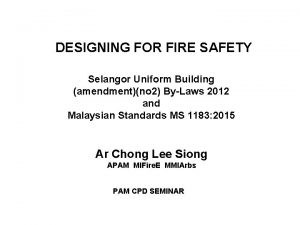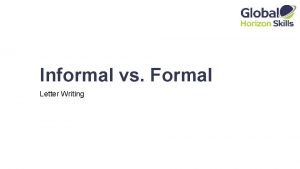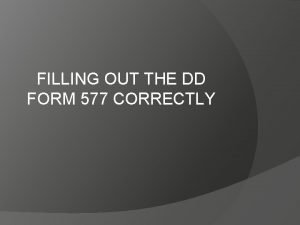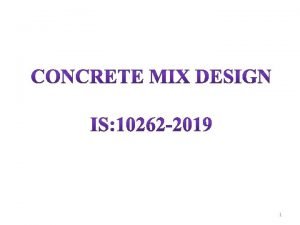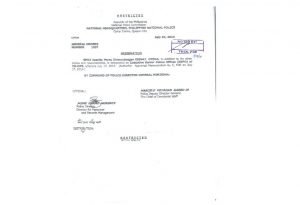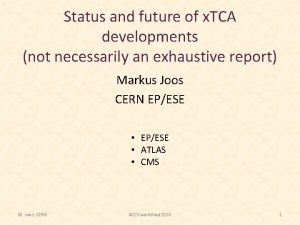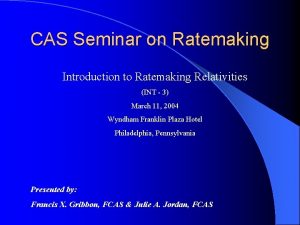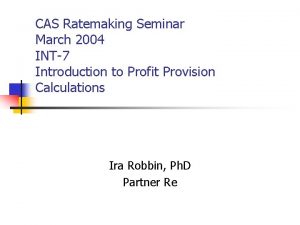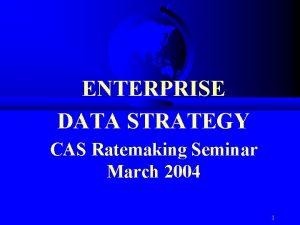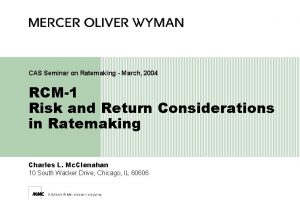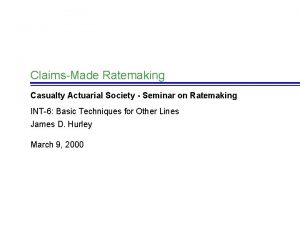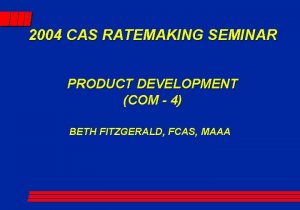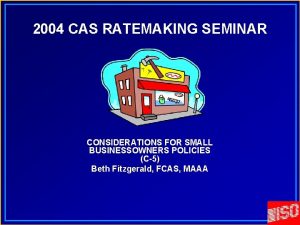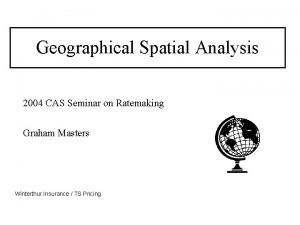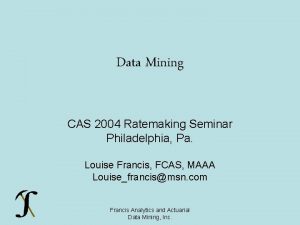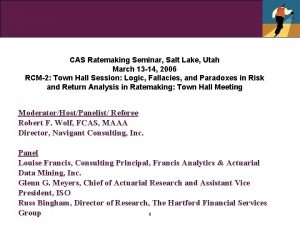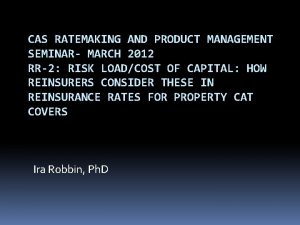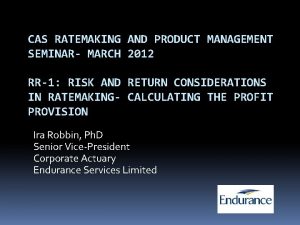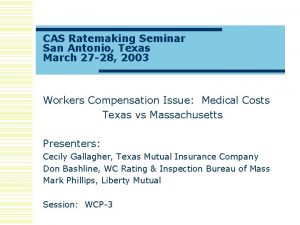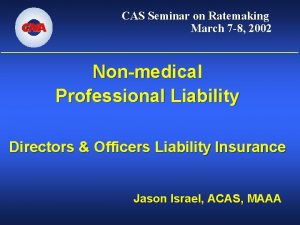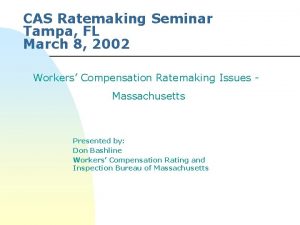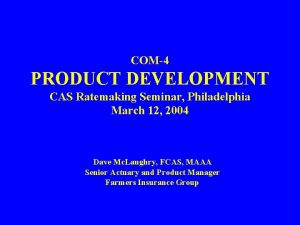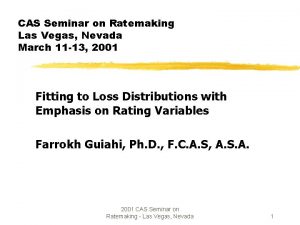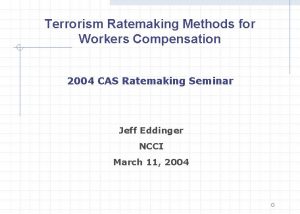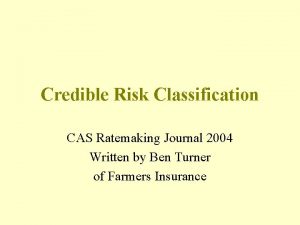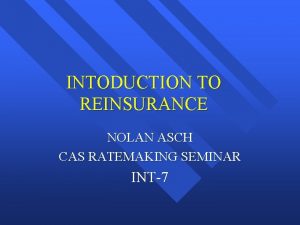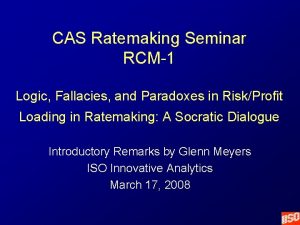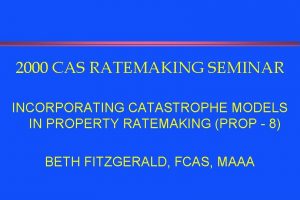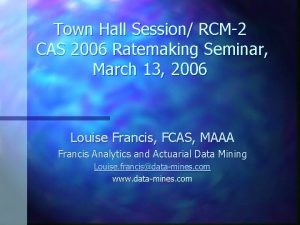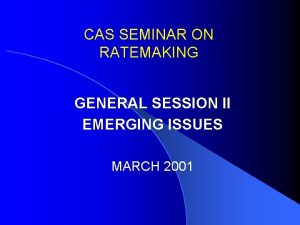CAS Ratemaking Seminar March 2004 WC5 Latest Developments







![Impact of LG Adjustment n n Assume MS/H = 1. Then: LUGS > E[L] Impact of LG Adjustment n n Assume MS/H = 1. Then: LUGS > E[L]](https://slidetodoc.com/presentation_image_h2/81f3cfa09c53ddbc1fb410f031953366/image-8.jpg)



















- Slides: 27

CAS Ratemaking Seminar March, 2004 WC-5 Latest Developments in Retrospective Rating Ideas for Future Development Ira Robbin, Ph. D Senior Pricing Actuary Partner RE

Ground Rules and Disclaimers n n n The purpose of this session is to promote actuarial discussion of possible improvements in NCCI Retro Rating Plans. Anti-trust guidelines will be scrupulously obeyed. No statements of Partner Re’s corporate position will be made or should be inferred.

Cautions n Examples are for illustrative purposes only. Do not use the results from any example in real-world applications.

Three Ideas n n n Refining ICRLL Filing an Advisory Agg Model Adding Terrorism and CAT Loadings n n Table M ELPF

ICRLL Review n n n Insurance Charge Reflecting Loss Limitation Logical modification of regular insurance charge calculation procedure Limited Loss Ratio Equations n n n Ratio Difference Value Difference Single Table M n Adjust Table M column (ELG)

ICRLL Ratio and Value Difference Expected Limited LR

Loss Group Adjustment n n n LUGS= Losses Used in Group Selection LUGS = E[L]*M S/H *Mk M S/H State/Hazard Group multiplier Mk per accident loss limit multiplier Mk = (1+. 8 LER)/(1 -LER) LER = ELPF/ELR
![Impact of LG Adjustment n n Assume MSH 1 Then LUGS EL Impact of LG Adjustment n n Assume MS/H = 1. Then: LUGS > E[L]](https://slidetodoc.com/presentation_image_h2/81f3cfa09c53ddbc1fb410f031953366/image-8.jpg)
Impact of LG Adjustment n n Assume MS/H = 1. Then: LUGS > E[L] > E[LL] Larger $ Loss a. Smaller LG # a. Smaller Ins Charges

ICRLL vs “Correct” Solution n ICRLL uses theoretically correct value difference and ratio difference equations ICRLL approximates limited loss distribution by using distribution for a larger risk Correct solution: Limited Loss Table Ms n Table M for each per occ loss limit

Unlimited and Limited Loss Table Ms

Limited Loss Table Ms vs Table L

ICRLL Approx of Insurance Charge Values n Approximation good for intermediate r n n May over-reduce charges for small r n n n ICRLL use of larger risk gives smaller charges Per occ limitation should reduce charges Calibration of ICRLL rating values $ savings for small min should not change when a loss limit is introduced ICRLL may incorrectly show $ savings reductions May or may not reduce charges enough for large r

Understated Savings Example

Charges for Tiny Loss Limits n n Let the loss limit approach zero Charges should approach charges for the accident count distribution ICRLL charges approach those of a very large risk Conclusion: ICRLL has incorrect asymptotic behavior as loss limit decreases

Actual vs Theoretical Error n ICRLL theoretical potential error n n Low loss limits Low entry ratios High entry ratios ICRLL actual error? n n Needs further study! Tolerance for inaccuracy

For Greater Accuracy: n Promulgate Limited Loss Table Ms n n n Interpolate between Unlimited Table M and Count Table M n n Theoretically right Horribly impractical Has correct asymptotic behavior Use LER as interpolation weight? Still seems impractical File an Aggregate Model

The Model Solution n Solution considered in early 90 s n n Need Count and Severity Distributions n n n Rejected due to need for paper tables Concern about regulatory approval Prior to Internet and Windows 95 Should closely reproduce current Table M Not a trivial task, but not impossible Refine the model used to develop Table M Develop practical software File as advisory Table M software

Model Solution: Pros and Cons n n Theoretically correct and most accurate Practical n n n A Solution in Search of a Problem n n Modeling problems difficult, not impossible Internet or CD implementation feasible ICRLL generally accurate enough For greater accuracy, use consultants or in-house actuaries Too costly Difficulties with regulatory approval

CAT and Terrorism Loadings n n n Some actual CAT & Terrorism may be implicitly in Table M and ELPFs May also be part of flat load in ELPFs Current expectation of CAT &Terror not in Table M or ELPF n Property CAT models a. WC CAT potential is signficant

CAT and Terrorism: Property vs WC n n n Wind less a concern in WC Quake loss in WC varies with time of day Terrorism may be more of a concern in WC n n Attacks on people that may cause modest property damage Chemical and biological threats

Occ and Agg Terrorism Exposure n Single event explosion n n Large occ exposure Chemical or biological attack n n May not immediately generate WC losses Could eventually spawn large number of WC cases

Method for Loading ELPF? n One idea: n n n Compute ELF as per current method Weight with severe CAT distribution Example: n n Regular ELF = 10% CAT ELF = 50% CAT weight = 2% Final ELF =. 98*10%+. 02*50% = 10. 8%

How to Load Table M? n Model exposure by peril and size of risk n n n Number of locations Number of workers per location Distribution of # injured and severity of injuries for each CAT and Terror peril per location Generate simulated WC CAT and Terror losses and probabilities Model regular loss with current Table M Convolve

Modeling Issues n Source for parameters n n Model equations Validation of results n n n Property CAT models Experts and consultants Some validation for CAT models Minimal validation of Terrorism models High degree of difficulty

Practical Issues n Need to exclude actual CAT and Terror claims from regular data n n Ideal CAT & Terror weight n n n Claim coding needed to identify CAT &Terror By location: state and zip Size of risk and public profile Density and vulnerability of workers WC data doesn’t capture key factors Regulatory issues

Pros and Cons n n Ought to reflect known exposures in the Retro plan No way to determine right model or select parameters – no data Too costly and impractical No real need exists n n Market already charges vulnerable risks Models available from consultants

Conclusion n n Balance: accuracy vs practicality Uses of Retro parameters and tables n n n Roles of key players n n Large Deductible and Dividend plans XS of OCC and AAD pricing Dual role of NCCI Consultants Regulators Questions and Comments
 March march dabrowski
March march dabrowski Wco data model latest version
Wco data model latest version Latest trands
Latest trands Rdso drawing rt-8527
Rdso drawing rt-8527 Sbm tools
Sbm tools Ms word latest version
Ms word latest version Andrew heywood comparative politics
Andrew heywood comparative politics Upstu
Upstu Citect scada latest version
Citect scada latest version Aqap
Aqap Christopher asked me if i wanted to dance
Christopher asked me if i wanted to dance Latest subject is integrity
Latest subject is integrity Latest electronics and information technology in odisha
Latest electronics and information technology in odisha Florence and the machine video
Florence and the machine video Staircase ubbl
Staircase ubbl Latest relocation trends
Latest relocation trends Oracle apex 19
Oracle apex 19 Prayer points for philippines
Prayer points for philippines Latest format of formal letter
Latest format of formal letter Dd form 577
Dd form 577 Sspc-pa 2
Sspc-pa 2 Is 10262 2019
Is 10262 2019 Indian pharmacopoeia latest edition
Indian pharmacopoeia latest edition Latest nbc code
Latest nbc code Pnp organizational structure 2021
Pnp organizational structure 2021 In the colonial era developments such as the new england
In the colonial era developments such as the new england Comtel atca
Comtel atca Political developments in the early republic
Political developments in the early republic



